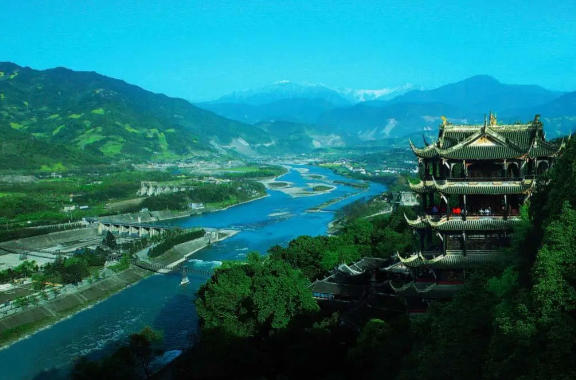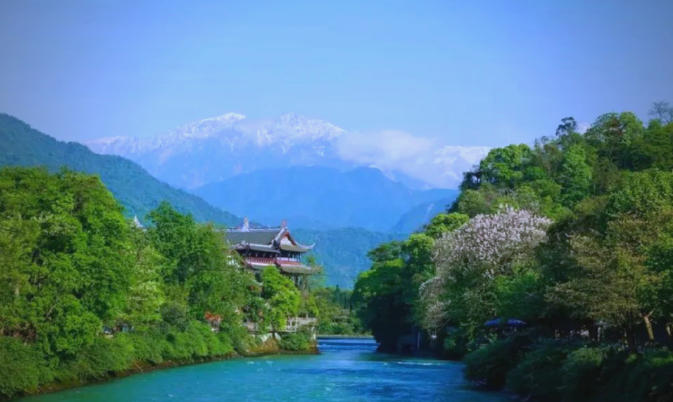A comprehensive guide to traveling in Dujiangyan, combining history, itineraries, accommodation, cuisine, and important tips to help you efficiently plan your trip:
I. Historical Background
Dujiangyan was first constructed in 256 BCE (during the Warring States Period) under the supervision of Li Bing, the governor of Shu Commandery of the Qin State, and his son. It is the world’s oldest damless irrigation system and continues to irrigate over 10 million acres of farmland in the Chengdu Plain to this day. Its core principle is “harnessing natural forces for irrigation without dams,” achieved through three main structures: the Fish Mouth Water Diversion Dike, the Flying Sand Weir Floodway, and the Bottle Neck Water Inlet, which enable automatic water diversion, sand removal, and flow control. The surrounding Qingcheng Mountain is the birthplace of Taoism, where Zhang Daoling of the Eastern Han Dynasty once practiced, blending hydraulic engineering wisdom with religious culture.

2. Recommended Tour Routes
One-Day Essentials Tour (Hydraulic Engineering + Ancient City)
Morning:
Dujiangyan Scenic Area (enter from the east gate to avoid congestion at the south gate)
→ Take the Bu Yun Lang escalator to ascend to the Yu Lei Pavilion for a panoramic view → Er Wang Temple → An Lan Suspension Bridge → Fish Mouth Water Diversion Dike.
Tips: Arrive at the scenic area before 8 a.m. to avoid crowds. Admission is 80 yuan (during peak season), and electronic tickets can be purchased to save money.
Afternoon:
Guanxian Ancient City: Stroll along Xingfu Road and West Street, try local snacks (Coconut Roll, Sweet Water Noodles) → Take a giant selfie with the panda at Yangtianwo Square → Enjoy the night view at South Bridge (lights turn on after 7:30 PM; the best spot to view the “Blue Tears” is at Tianfu Yuan Corridor Bridge, which is less crowded and offers beautiful scenery).
Two-day in-depth tour (nature + culture)
Day 1: Dujiangyan Scenic Area + Guanghan Ancient City (as above).
Day 2:
Panda Valley (opens at 8:00 AM; arrive early to watch the giant pandas being fed) → Qingcheng Mountain Front Range (Daoist temples: Tianshi Cave, Shangqing Palace) or Back Range (Wulong Gorge hike, ideal for summer retreats).
Alternatives: Hongkou Rafting (summer) or Wanda Cultural Tourism City Skiing (family-friendly).
Route Map Overview
Panda Valley → Yangtianwo Square → Guanghan Ancient City → Dujiangyan Scenic Area → Nanqiao Night View (core one-day itinerary, time-saving and convenient)

III. Hotel Recommendations
Type Recommended Hotel Features Reference Price/Night
City Center Convenience Dujiangyan Central International Hotel Near high-speed rail station, well-equipped facilities 300–500 RMB
Near Scenic Area Qingcheng Howard Johnson International Hotel Next to Dui Park, night view of the water conservancy project’s lights 600-800 RMB
Unique Guesthouse Wuyi Secret Garden (Qingcheng Mountain Branch) Japanese-style courtyard + private hot spring, hidden in the mountains 800-1200 RMB
Ancient City Charm Xianzai · Houshe Guesthouse (Inside Guangxian Ancient City) Renovated old house, convenient for sightseeing and dining 400-600 RMB
During the peak season (April to October), reservations must be made 1-2 weeks in advance. Guesthouses can be contacted directly via WeChat.
4. Food Recommendations
Must-try specialties:
Qingcheng Four Treasures: Ginkgo Nut Stewed Chicken (He Xiang Mountain Villa), Dongtian Milk Wine (fruit wine), Qingcheng Pickles, Qingcheng Bitter Tea.
Snack hubs: Yangliu River Street/Wuguibridge Street in Guangxian Ancient City
→Coconut Rolls (Coconut Rolls from the Cultural Revolution), Zhong Duck (Sweet-Skinned Duck), Zhao’s Noodles (Sweet Water Noodles), Ye Po Po Soy Milk Bread (Intangible Cultural Heritage).
Late-Night Snacks: “Night Beer Alley” by Nanqiao Bridge, try stir-fried lobster, spicy crab, paired with local beer.
Restaurant Recommendations
Lao Hao You Tu Tou: Spicy Rabbit Head (a specialty of Dujiangyan).
Luo Ji Rou: Qingcheng Mountain-area farmhouse restaurants, offering firewood-cooked chicken and tofu rice.
5. Important Notes
Fraud Warning:
Many individuals offering rides on electric scooters near highway exits or tourist attractions are scammers who claim to offer “free admission and guided tours” but actually lure visitors into high-priced dining establishments. Do not follow them.
Activities like rafting within scenic areas offer poor value for money; choose carefully.
Weather and Gear:
July often sees heavy rain; avoid flooded roads (e.g., Juying Road at Yuyan Intersection, Yong’an Avenue at Xuefu Intersection); bring rain gear and slip-resistant shoes.
Temperature differences are significant in mountainous areas (20-28°C). Bring a light jacket, and mosquito repellent and sunscreen are essential.
Transportation Tips:
From Chengdu, the high-speed rail is the preferred option (Xipu → Lidi Park Station, 30 minutes). Take a taxi from the station for 10 yuan to the scenic area.
There is a lot of walking within the scenic area, so wear comfortable sneakers. For those with children, consider hiring a private car for sightseeing (approximately 300 yuan per day).
Other:
Panda Valley requires advance booking; pandas are more likely to sleep in the afternoon, so arrive early.
At Nanqiao “Blue Tears,” adjust your phone’s color temperature to 3000K for better photos.
Summary: Dujiangyan is centered around its thousand-year-old hydraulic engineering marvel, complemented by the Taoist mystique of Qingcheng Mountain and the charm of pandas. A two-day trip allows for a deep exploration. For a more compact itinerary, focus on the hydraulic engineering and ancient city in one day. Prioritize local snacks from Guanghan County for dining, and choose accommodations based on your needs—convenient hotels or mountain-side guesthouses. Be cautious of solicitation scams, and exercise caution on low-lying roads during rainy weather!